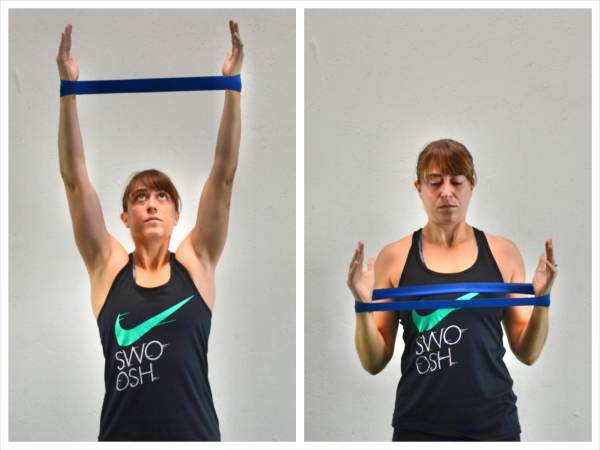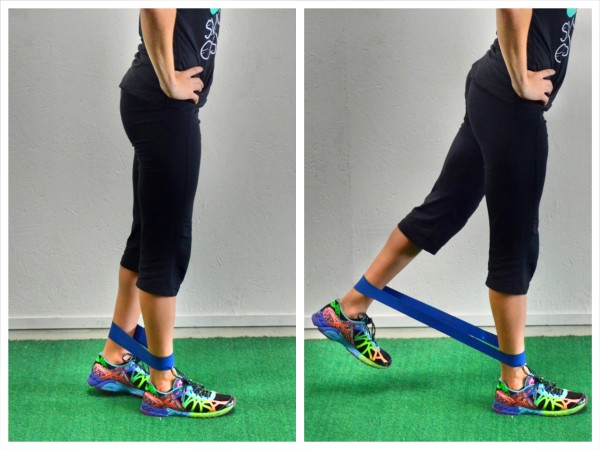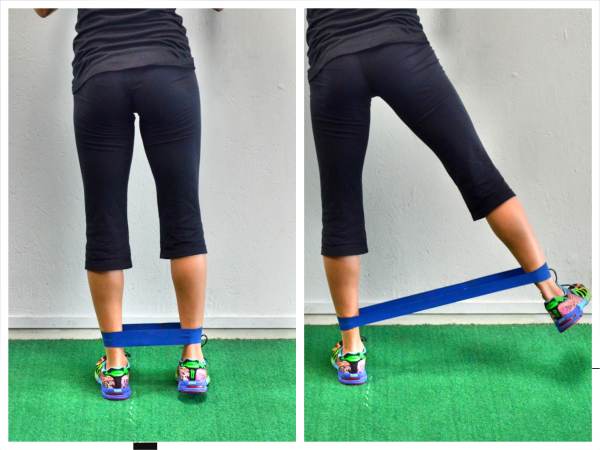WARM UP
Stretch and Roll Out:
Calves
Hamstrings
Quads
Groin
Hips/Glutes
Chest/Shoulders/Traps
Back/Lats
ACTIVATION
After stretch and rolling, complete 2 rounds of the circuit below.
CIRCUIT:
10 reps Mini Band Scapular Flyes
10 reps Mini Band Pull Downs
15 reps Mini Band Standing Kickbacks
15 reps Mini Band Lateral Raises
WORKOUT
Set a timer for 30 seconds – 1 minute. Only hold for 1 minute if you can maintain good form the entire time. Switch from one exercise to the next, resting as needed between rounds. Complete 4-6 rounds of the circuit.
CIRCUIT:
30 seconds – 1 minute each side Warrior III
30 seconds – 1 minute Pull Up Hold Variations (you can even move between them during the time)
30 seconds – 1 minute Glute Bridge Hold
30 seconds – 1 minute Dip Hold
30 seconds – 1 minute Banana Hold
CONDITIONING
Set a timer for 5-10 minutes. Perform locomotion (jogging, back pedaling, shuffling, carioca, skips) at 75% of your max effort so your heart rate gets up but you can move consistently the entire time without redlining.
COOL DOWN
Stretch and Roll Out:
Calves
Hamstrings
Quads
Groin
Hips/Glutes
Chest/Shoulders/Traps
Back/Lats
NOTES:
During the Pull Up Holds, you can move between all three, holding only a few seconds at each, or you can pick one to do for all of the rounds or even alternate holds between rounds. You can also do the Glute Bridge as a Single Leg Glute Bridge Hold.
If you do the Single Leg, hold on one side for 30 seconds to 1 minute before switching to the other side. Do not move on to the Dip Hold until you’ve held on both sides. For the Banana Hold, beginners may need to do a variation of the Pelvic Tilt to make sure their abs and not their backs are working.
EXERCISE DESCRIPTIONS:
Mini Band Scapular Flyes – To do the Scapular Flyes, place the mini band around your arms. The closer to your elbow the band goes, the easier the move will be. To make the move harder, place the band around your wrists or hands. Press out on the band so there is some tension and extend your arms in front of you at about shoulder height. Stand up nice and tall and press your chest out, retracting your shoulder blades down and together. Then press out on the band, pulling it as far apart as you can, flying your arms out to the sides. Feel the muscles between your shoulder blades work to pull your arms open. Once you’ve pulled the band as far apart as you can, slowly return to the starting position. Stay in control of the movement the entire time and don’t let the band pull you.

Mini Band Pull Downs – To do the Pulldown, you can either hold the band in each hand or place it around the back of your hands, wrists or even your forearms. Do not hold it in your hands if you can’t keep tension on the band the entire time. To make the move easier, place the band on your arms closer to your elbows. Then with the band around each arm, extend your hands up toward the ceiling. Stand tall, pressing your chest out and squeezing your glutes. Draw your shoulder blades down and back. Then, keeping tension on the band and your arms about shoulder-width apart, pull the band down toward your chest. Feel the sides of your back working to pull the band down to your chest with your chest pressed out and open toward the ceiling. Hold for a second at your chest and then extend your arms back up toward the ceiling. You can either do this move for repetitions or you can hold the band down at your chest for an isometric move. No matter which you do, make sure to consciously engage your back and draw your shoulder blades down and back. Make sure you keep tension on the band the entire time. Also make sure you do not arch your low back as you perform the move. Keep your abs braced so you don’t feel it in your low back.

Mini Band Standing Kickbacks – To do the Standing Kickback, place the band around your ankles. Higher up on your leg will make the movement a bit easier. Face a wall, chair or anything you can use to slightly balance with. Stand with a soft knee while you lift the other foot off the ground and kick it behind you. Keep the leg fairly straight and flex your foot so you are driving the heel back into the wall behind you. Squeeze your glute as you lift. Do not rock forward to try to get the leg up higher. Height doesn’t matter. Just focus on squeezing your glute and keeping your core tight. You may have a very slight lean forward as you stabilize on the standing leg, but you don’t want to rock forward and open up your hip just to kick back higher. Rocking forward may also put the move in your low back instead of forcing your glute to work to lift the leg. Hold at the top and then lower down and repeat on the same side. It may not be a huge range of motion. The important part is to really squeeze the glute and not just hyperextend your low back to kick the leg back higher. If you really struggle to keep from rocking or putting the move in your low back, you may want to lie face down on the ground and try the kickback or use a lighter resistance. Really consciously squeeze your glutes as you lift.

Mini Band Lateral Raises – To do the Standing Lateral Raises, place the band around your ankles. Face a wall, chair or anything you can use to slightly balance with. Stand with a soft knee while you lift the other off the ground and out to the side. Keep the leg straight (but don’t lock out the knee) and lift to the side. Try not to let the toe rotate open so that the move stays focused on your abductors. Keep the foot you are lifting parallel to the foot on the ground. Squeeze your butt as you lift. Do not lean to the side just to lift the leg higher. Keep the core tight and stand up nice and tall. Hold for a second at the top and then lower and repeat. Complete all reps on that side. You may also feel this in the standing glute as well because that leg is working to resist the band and keep you stabile. You may find you lean a little to stabilize on the standing leg on the first one and that is fine. The point is just not to actively lean away to raise the leg up higher or to rock as you lift. If you wish to work your external rotators more, you can then turn your toe open as you lift. Just be aware that it is a different movement and working the muscles in a different way. Beginners may need to use a lighter band or even no band at all to start. They may also find that a Lying Lateral Raise is easier to control.

For descriptions of all of the Isometric Exercises and even more Isometrics to work your core, check out these 10 Core Isometric Exercises.